Financial Analysis of Voltas Communication: Costing Assignment 2019
VerifiedAdded on 2022/11/10
|14
|2666
|426
Report
AI Summary
This report analyzes the costing methods used by Voltas Communication, focusing on job costing and activity-based costing. The assignment calculates manufacturing overhead, material consumption, and overhead recovery rates. It addresses the treatment of under and over-applied overheads, comparing methods like charging to cost of goods sold, apportionment, and allocation to specific jobs, recommending the latter. The report also evaluates the suitability of activity-based costing for Voltas Communication, discussing its advantages in allocating indirect costs and providing detailed calculations for closing stock valuation. The analysis covers various aspects of costing, including direct materials, labor, and overheads, providing a comprehensive overview of the company's financial data and cost allocation strategies.
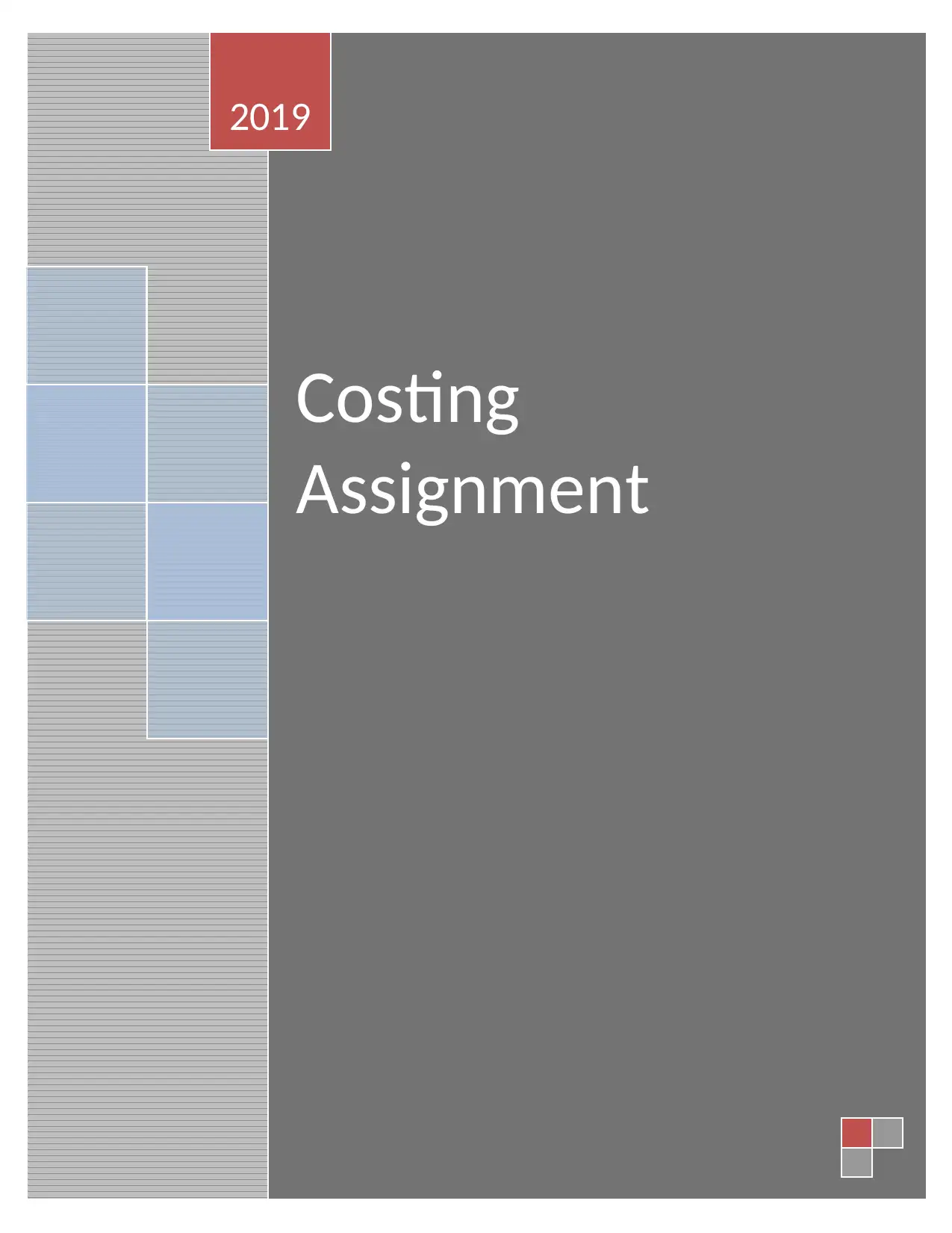
Costing
Assignment
2019
Assignment
2019
Paraphrase This Document
Need a fresh take? Get an instant paraphrase of this document with our AI Paraphraser
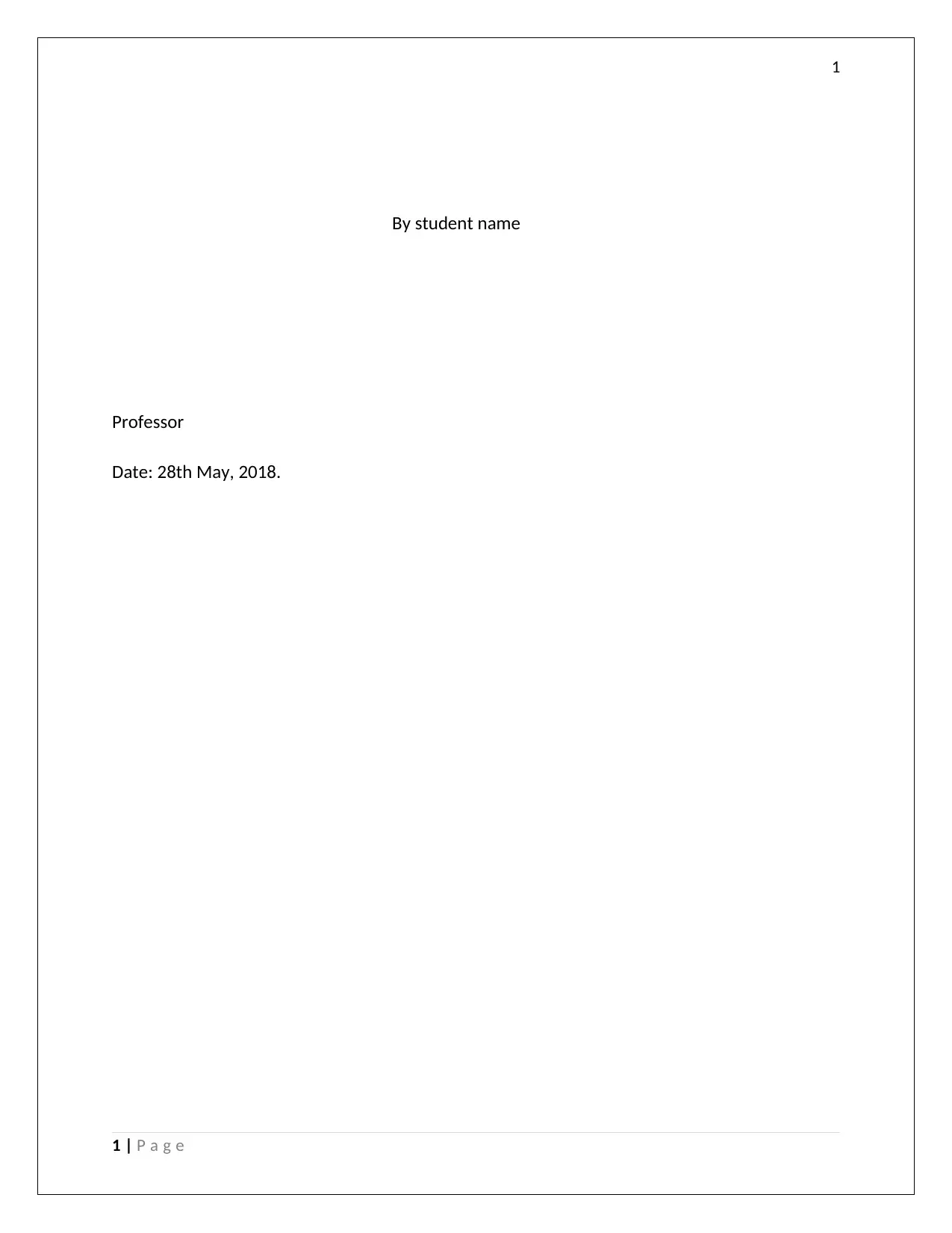
1
By student name
Professor
Date: 28th May, 2018.
1 | P a g e
By student name
Professor
Date: 28th May, 2018.
1 | P a g e
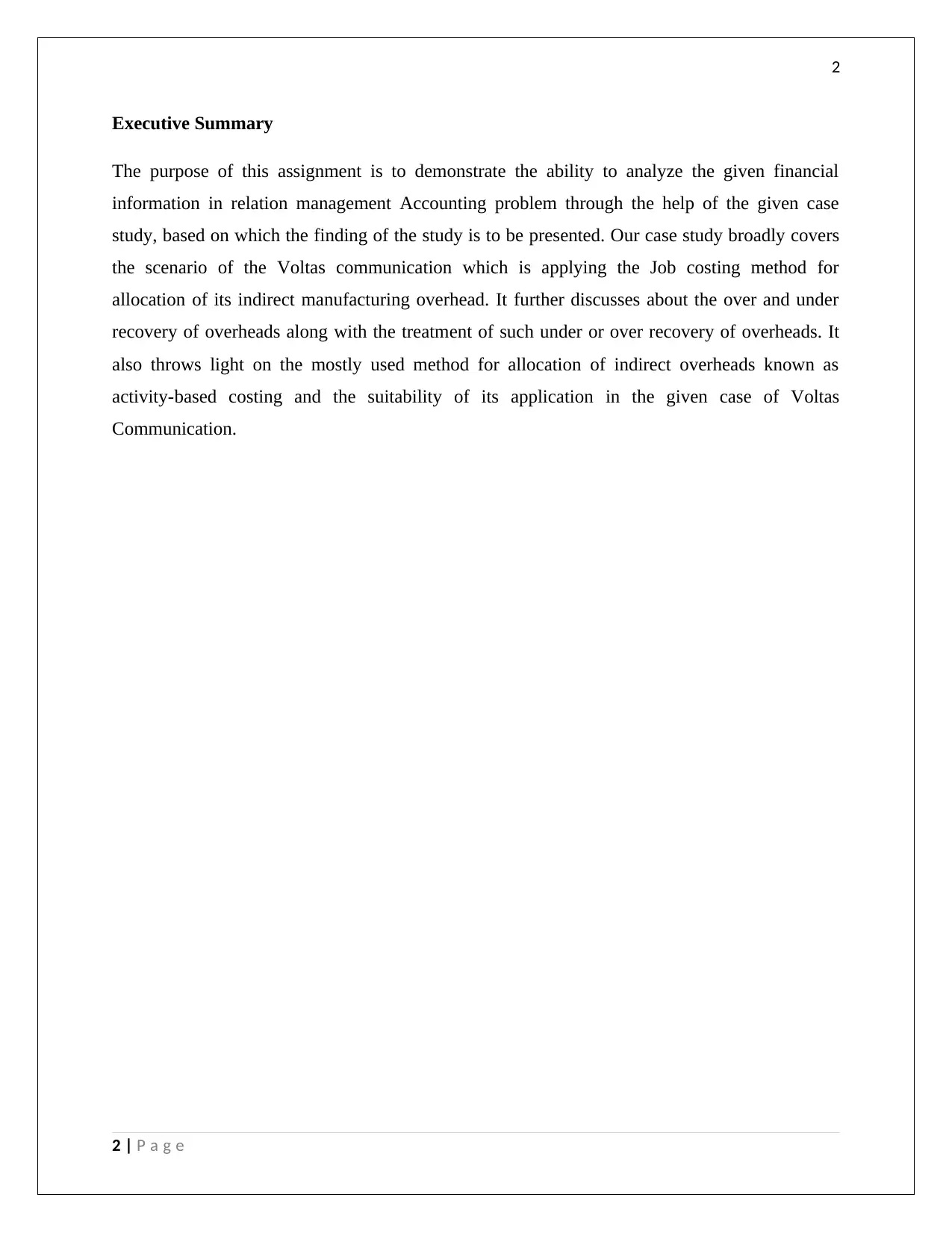
2
Executive Summary
The purpose of this assignment is to demonstrate the ability to analyze the given financial
information in relation management Accounting problem through the help of the given case
study, based on which the finding of the study is to be presented. Our case study broadly covers
the scenario of the Voltas communication which is applying the Job costing method for
allocation of its indirect manufacturing overhead. It further discusses about the over and under
recovery of overheads along with the treatment of such under or over recovery of overheads. It
also throws light on the mostly used method for allocation of indirect overheads known as
activity-based costing and the suitability of its application in the given case of Voltas
Communication.
2 | P a g e
Executive Summary
The purpose of this assignment is to demonstrate the ability to analyze the given financial
information in relation management Accounting problem through the help of the given case
study, based on which the finding of the study is to be presented. Our case study broadly covers
the scenario of the Voltas communication which is applying the Job costing method for
allocation of its indirect manufacturing overhead. It further discusses about the over and under
recovery of overheads along with the treatment of such under or over recovery of overheads. It
also throws light on the mostly used method for allocation of indirect overheads known as
activity-based costing and the suitability of its application in the given case of Voltas
Communication.
2 | P a g e
⊘ This is a preview!⊘
Do you want full access?
Subscribe today to unlock all pages.

Trusted by 1+ million students worldwide
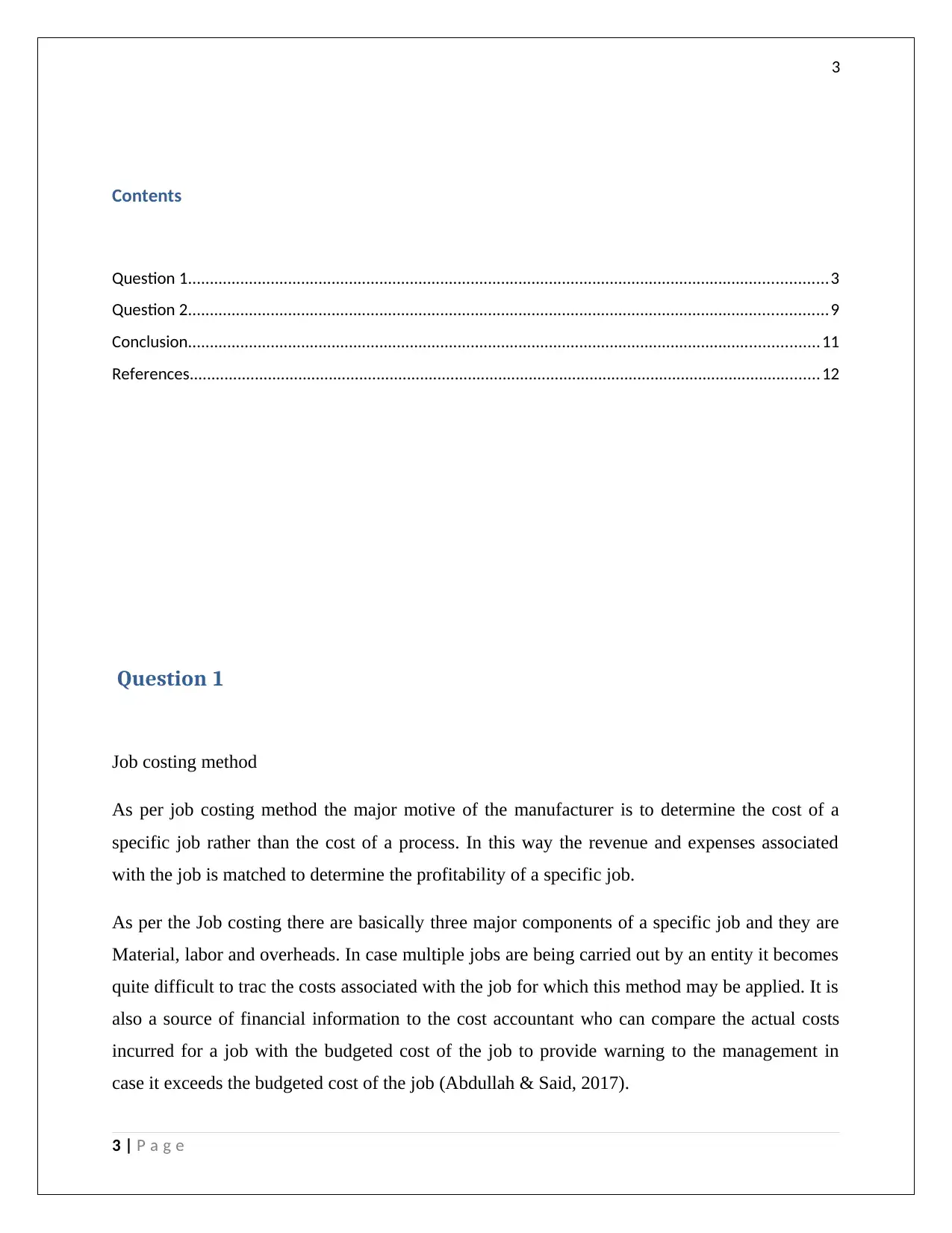
3
Contents
Question 1...................................................................................................................................................3
Question 2...................................................................................................................................................9
Conclusion.................................................................................................................................................11
References.................................................................................................................................................12
Question 1
Job costing method
As per job costing method the major motive of the manufacturer is to determine the cost of a
specific job rather than the cost of a process. In this way the revenue and expenses associated
with the job is matched to determine the profitability of a specific job.
As per the Job costing there are basically three major components of a specific job and they are
Material, labor and overheads. In case multiple jobs are being carried out by an entity it becomes
quite difficult to trac the costs associated with the job for which this method may be applied. It is
also a source of financial information to the cost accountant who can compare the actual costs
incurred for a job with the budgeted cost of the job to provide warning to the management in
case it exceeds the budgeted cost of the job (Abdullah & Said, 2017).
3 | P a g e
Contents
Question 1...................................................................................................................................................3
Question 2...................................................................................................................................................9
Conclusion.................................................................................................................................................11
References.................................................................................................................................................12
Question 1
Job costing method
As per job costing method the major motive of the manufacturer is to determine the cost of a
specific job rather than the cost of a process. In this way the revenue and expenses associated
with the job is matched to determine the profitability of a specific job.
As per the Job costing there are basically three major components of a specific job and they are
Material, labor and overheads. In case multiple jobs are being carried out by an entity it becomes
quite difficult to trac the costs associated with the job for which this method may be applied. It is
also a source of financial information to the cost accountant who can compare the actual costs
incurred for a job with the budgeted cost of the job to provide warning to the management in
case it exceeds the budgeted cost of the job (Abdullah & Said, 2017).
3 | P a g e
Paraphrase This Document
Need a fresh take? Get an instant paraphrase of this document with our AI Paraphraser
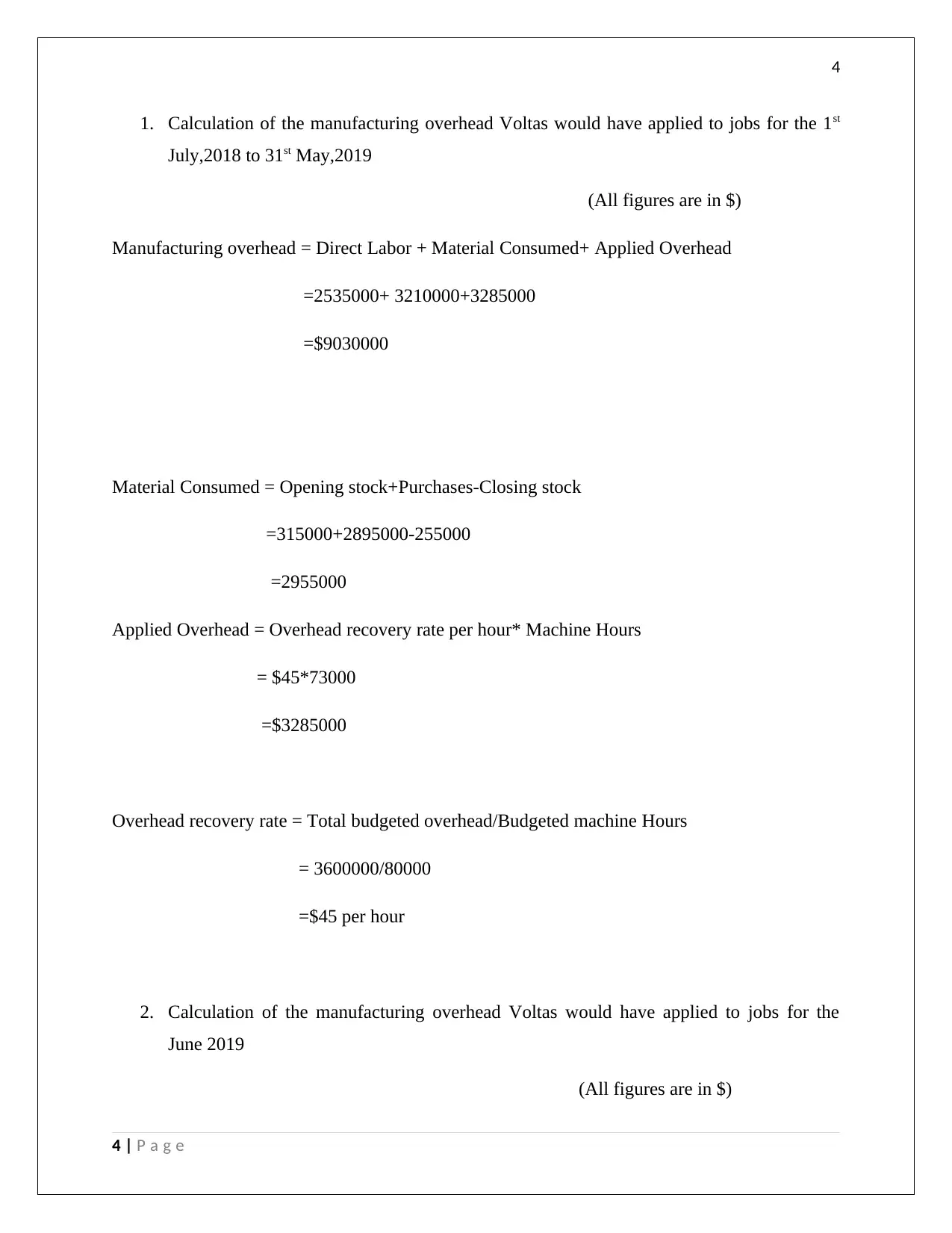
4
1. Calculation of the manufacturing overhead Voltas would have applied to jobs for the 1st
July,2018 to 31st May,2019
(All figures are in $)
Manufacturing overhead = Direct Labor + Material Consumed+ Applied Overhead
=2535000+ 3210000+3285000
=$9030000
Material Consumed = Opening stock+Purchases-Closing stock
=315000+2895000-255000
=2955000
Applied Overhead = Overhead recovery rate per hour* Machine Hours
= $45*73000
=$3285000
Overhead recovery rate = Total budgeted overhead/Budgeted machine Hours
= 3600000/80000
=$45 per hour
2. Calculation of the manufacturing overhead Voltas would have applied to jobs for the
June 2019
(All figures are in $)
4 | P a g e
1. Calculation of the manufacturing overhead Voltas would have applied to jobs for the 1st
July,2018 to 31st May,2019
(All figures are in $)
Manufacturing overhead = Direct Labor + Material Consumed+ Applied Overhead
=2535000+ 3210000+3285000
=$9030000
Material Consumed = Opening stock+Purchases-Closing stock
=315000+2895000-255000
=2955000
Applied Overhead = Overhead recovery rate per hour* Machine Hours
= $45*73000
=$3285000
Overhead recovery rate = Total budgeted overhead/Budgeted machine Hours
= 3600000/80000
=$45 per hour
2. Calculation of the manufacturing overhead Voltas would have applied to jobs for the
June 2019
(All figures are in $)
4 | P a g e
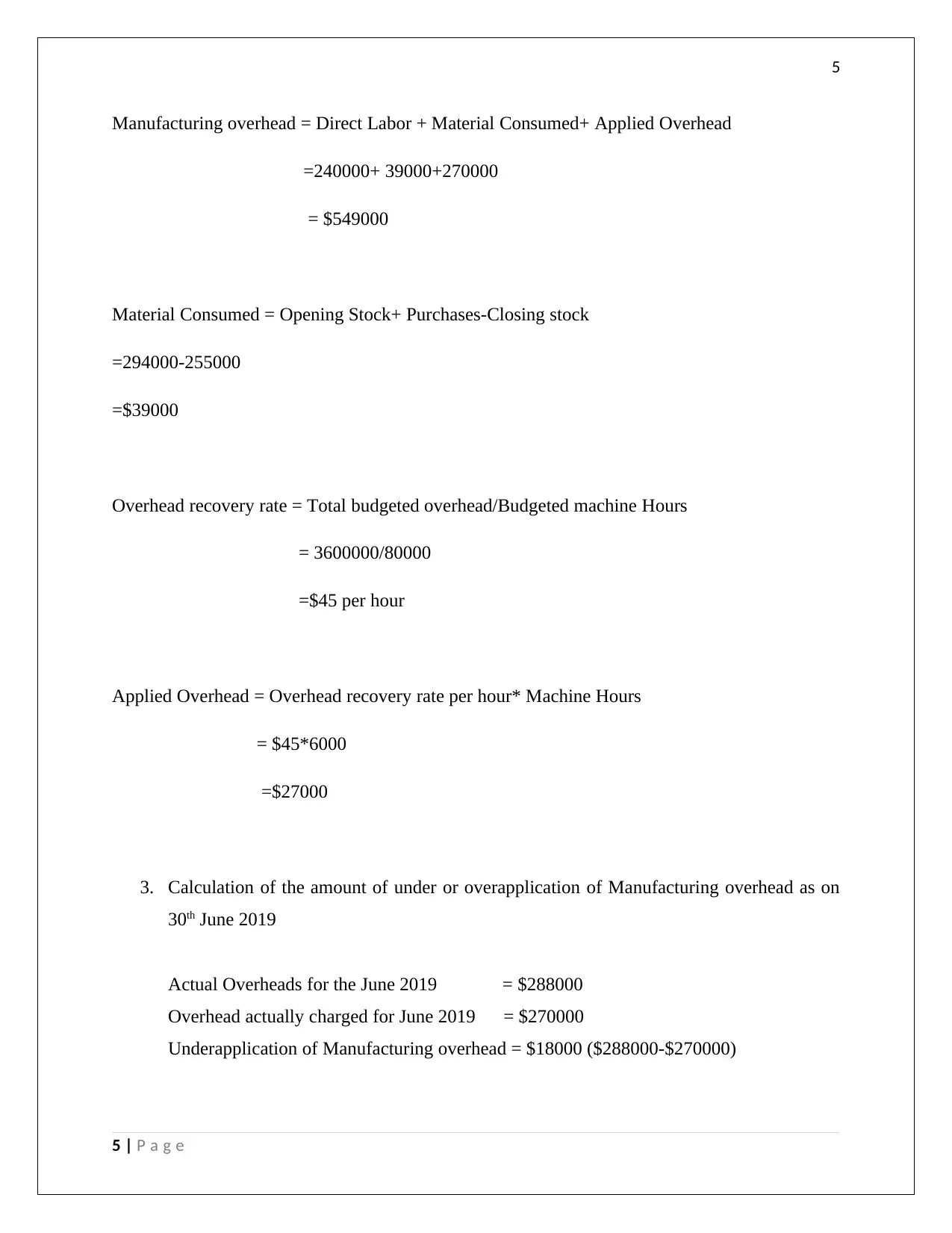
5
Manufacturing overhead = Direct Labor + Material Consumed+ Applied Overhead
=240000+ 39000+270000
= $549000
Material Consumed = Opening Stock+ Purchases-Closing stock
=294000-255000
=$39000
Overhead recovery rate = Total budgeted overhead/Budgeted machine Hours
= 3600000/80000
=$45 per hour
Applied Overhead = Overhead recovery rate per hour* Machine Hours
= $45*6000
=$27000
3. Calculation of the amount of under or overapplication of Manufacturing overhead as on
30th June 2019
Actual Overheads for the June 2019 = $288000
Overhead actually charged for June 2019 = $270000
Underapplication of Manufacturing overhead = $18000 ($288000-$270000)
5 | P a g e
Manufacturing overhead = Direct Labor + Material Consumed+ Applied Overhead
=240000+ 39000+270000
= $549000
Material Consumed = Opening Stock+ Purchases-Closing stock
=294000-255000
=$39000
Overhead recovery rate = Total budgeted overhead/Budgeted machine Hours
= 3600000/80000
=$45 per hour
Applied Overhead = Overhead recovery rate per hour* Machine Hours
= $45*6000
=$27000
3. Calculation of the amount of under or overapplication of Manufacturing overhead as on
30th June 2019
Actual Overheads for the June 2019 = $288000
Overhead actually charged for June 2019 = $270000
Underapplication of Manufacturing overhead = $18000 ($288000-$270000)
5 | P a g e
⊘ This is a preview!⊘
Do you want full access?
Subscribe today to unlock all pages.

Trusted by 1+ million students worldwide
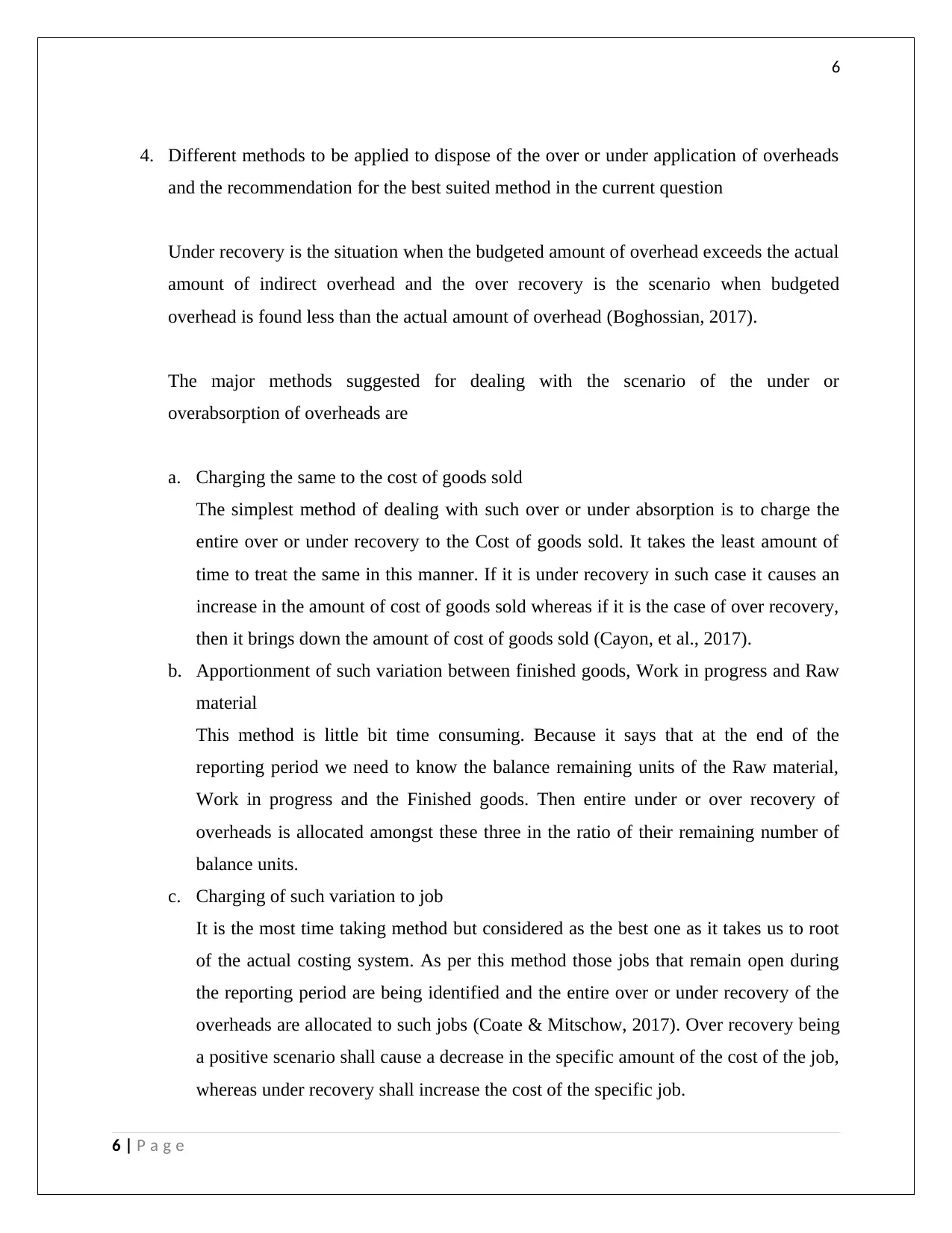
6
4. Different methods to be applied to dispose of the over or under application of overheads
and the recommendation for the best suited method in the current question
Under recovery is the situation when the budgeted amount of overhead exceeds the actual
amount of indirect overhead and the over recovery is the scenario when budgeted
overhead is found less than the actual amount of overhead (Boghossian, 2017).
The major methods suggested for dealing with the scenario of the under or
overabsorption of overheads are
a. Charging the same to the cost of goods sold
The simplest method of dealing with such over or under absorption is to charge the
entire over or under recovery to the Cost of goods sold. It takes the least amount of
time to treat the same in this manner. If it is under recovery in such case it causes an
increase in the amount of cost of goods sold whereas if it is the case of over recovery,
then it brings down the amount of cost of goods sold (Cayon, et al., 2017).
b. Apportionment of such variation between finished goods, Work in progress and Raw
material
This method is little bit time consuming. Because it says that at the end of the
reporting period we need to know the balance remaining units of the Raw material,
Work in progress and the Finished goods. Then entire under or over recovery of
overheads is allocated amongst these three in the ratio of their remaining number of
balance units.
c. Charging of such variation to job
It is the most time taking method but considered as the best one as it takes us to root
of the actual costing system. As per this method those jobs that remain open during
the reporting period are being identified and the entire over or under recovery of the
overheads are allocated to such jobs (Coate & Mitschow, 2017). Over recovery being
a positive scenario shall cause a decrease in the specific amount of the cost of the job,
whereas under recovery shall increase the cost of the specific job.
6 | P a g e
4. Different methods to be applied to dispose of the over or under application of overheads
and the recommendation for the best suited method in the current question
Under recovery is the situation when the budgeted amount of overhead exceeds the actual
amount of indirect overhead and the over recovery is the scenario when budgeted
overhead is found less than the actual amount of overhead (Boghossian, 2017).
The major methods suggested for dealing with the scenario of the under or
overabsorption of overheads are
a. Charging the same to the cost of goods sold
The simplest method of dealing with such over or under absorption is to charge the
entire over or under recovery to the Cost of goods sold. It takes the least amount of
time to treat the same in this manner. If it is under recovery in such case it causes an
increase in the amount of cost of goods sold whereas if it is the case of over recovery,
then it brings down the amount of cost of goods sold (Cayon, et al., 2017).
b. Apportionment of such variation between finished goods, Work in progress and Raw
material
This method is little bit time consuming. Because it says that at the end of the
reporting period we need to know the balance remaining units of the Raw material,
Work in progress and the Finished goods. Then entire under or over recovery of
overheads is allocated amongst these three in the ratio of their remaining number of
balance units.
c. Charging of such variation to job
It is the most time taking method but considered as the best one as it takes us to root
of the actual costing system. As per this method those jobs that remain open during
the reporting period are being identified and the entire over or under recovery of the
overheads are allocated to such jobs (Coate & Mitschow, 2017). Over recovery being
a positive scenario shall cause a decrease in the specific amount of the cost of the job,
whereas under recovery shall increase the cost of the specific job.
6 | P a g e
Paraphrase This Document
Need a fresh take? Get an instant paraphrase of this document with our AI Paraphraser
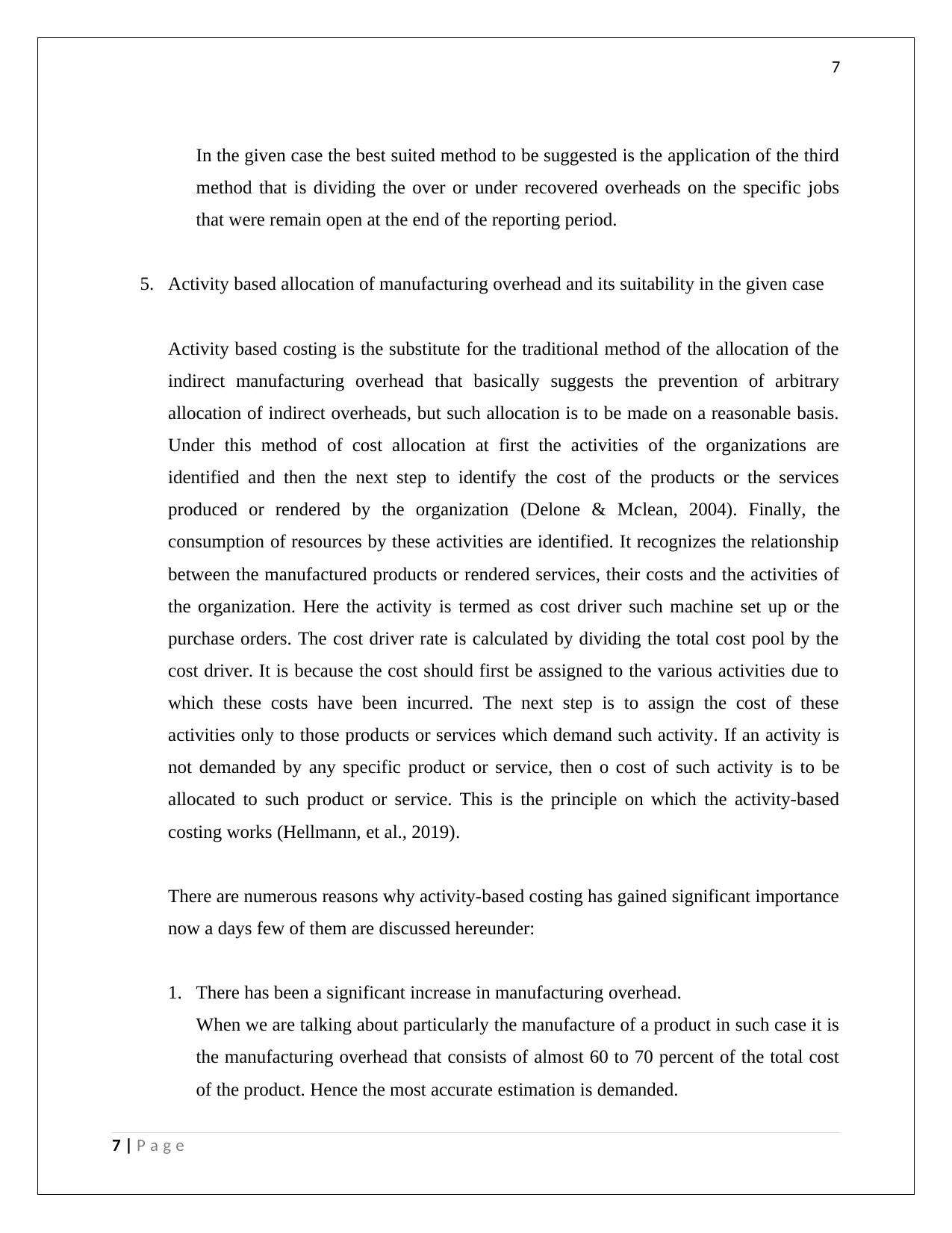
7
In the given case the best suited method to be suggested is the application of the third
method that is dividing the over or under recovered overheads on the specific jobs
that were remain open at the end of the reporting period.
5. Activity based allocation of manufacturing overhead and its suitability in the given case
Activity based costing is the substitute for the traditional method of the allocation of the
indirect manufacturing overhead that basically suggests the prevention of arbitrary
allocation of indirect overheads, but such allocation is to be made on a reasonable basis.
Under this method of cost allocation at first the activities of the organizations are
identified and then the next step to identify the cost of the products or the services
produced or rendered by the organization (Delone & Mclean, 2004). Finally, the
consumption of resources by these activities are identified. It recognizes the relationship
between the manufactured products or rendered services, their costs and the activities of
the organization. Here the activity is termed as cost driver such machine set up or the
purchase orders. The cost driver rate is calculated by dividing the total cost pool by the
cost driver. It is because the cost should first be assigned to the various activities due to
which these costs have been incurred. The next step is to assign the cost of these
activities only to those products or services which demand such activity. If an activity is
not demanded by any specific product or service, then o cost of such activity is to be
allocated to such product or service. This is the principle on which the activity-based
costing works (Hellmann, et al., 2019).
There are numerous reasons why activity-based costing has gained significant importance
now a days few of them are discussed hereunder:
1. There has been a significant increase in manufacturing overhead.
When we are talking about particularly the manufacture of a product in such case it is
the manufacturing overhead that consists of almost 60 to 70 percent of the total cost
of the product. Hence the most accurate estimation is demanded.
7 | P a g e
In the given case the best suited method to be suggested is the application of the third
method that is dividing the over or under recovered overheads on the specific jobs
that were remain open at the end of the reporting period.
5. Activity based allocation of manufacturing overhead and its suitability in the given case
Activity based costing is the substitute for the traditional method of the allocation of the
indirect manufacturing overhead that basically suggests the prevention of arbitrary
allocation of indirect overheads, but such allocation is to be made on a reasonable basis.
Under this method of cost allocation at first the activities of the organizations are
identified and then the next step to identify the cost of the products or the services
produced or rendered by the organization (Delone & Mclean, 2004). Finally, the
consumption of resources by these activities are identified. It recognizes the relationship
between the manufactured products or rendered services, their costs and the activities of
the organization. Here the activity is termed as cost driver such machine set up or the
purchase orders. The cost driver rate is calculated by dividing the total cost pool by the
cost driver. It is because the cost should first be assigned to the various activities due to
which these costs have been incurred. The next step is to assign the cost of these
activities only to those products or services which demand such activity. If an activity is
not demanded by any specific product or service, then o cost of such activity is to be
allocated to such product or service. This is the principle on which the activity-based
costing works (Hellmann, et al., 2019).
There are numerous reasons why activity-based costing has gained significant importance
now a days few of them are discussed hereunder:
1. There has been a significant increase in manufacturing overhead.
When we are talking about particularly the manufacture of a product in such case it is
the manufacturing overhead that consists of almost 60 to 70 percent of the total cost
of the product. Hence the most accurate estimation is demanded.
7 | P a g e
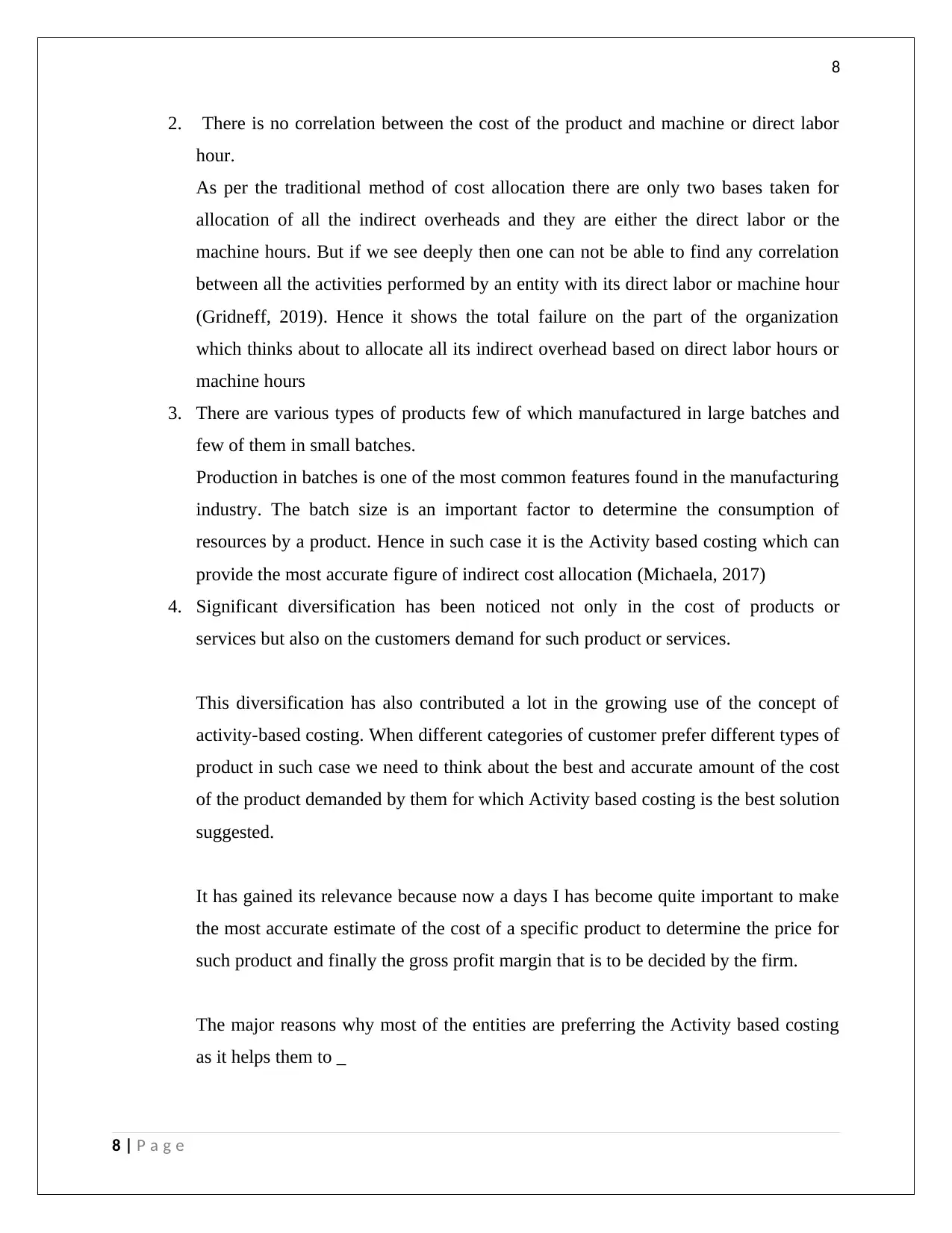
8
2. There is no correlation between the cost of the product and machine or direct labor
hour.
As per the traditional method of cost allocation there are only two bases taken for
allocation of all the indirect overheads and they are either the direct labor or the
machine hours. But if we see deeply then one can not be able to find any correlation
between all the activities performed by an entity with its direct labor or machine hour
(Gridneff, 2019). Hence it shows the total failure on the part of the organization
which thinks about to allocate all its indirect overhead based on direct labor hours or
machine hours
3. There are various types of products few of which manufactured in large batches and
few of them in small batches.
Production in batches is one of the most common features found in the manufacturing
industry. The batch size is an important factor to determine the consumption of
resources by a product. Hence in such case it is the Activity based costing which can
provide the most accurate figure of indirect cost allocation (Michaela, 2017)
4. Significant diversification has been noticed not only in the cost of products or
services but also on the customers demand for such product or services.
This diversification has also contributed a lot in the growing use of the concept of
activity-based costing. When different categories of customer prefer different types of
product in such case we need to think about the best and accurate amount of the cost
of the product demanded by them for which Activity based costing is the best solution
suggested.
It has gained its relevance because now a days I has become quite important to make
the most accurate estimate of the cost of a specific product to determine the price for
such product and finally the gross profit margin that is to be decided by the firm.
The major reasons why most of the entities are preferring the Activity based costing
as it helps them to _
8 | P a g e
2. There is no correlation between the cost of the product and machine or direct labor
hour.
As per the traditional method of cost allocation there are only two bases taken for
allocation of all the indirect overheads and they are either the direct labor or the
machine hours. But if we see deeply then one can not be able to find any correlation
between all the activities performed by an entity with its direct labor or machine hour
(Gridneff, 2019). Hence it shows the total failure on the part of the organization
which thinks about to allocate all its indirect overhead based on direct labor hours or
machine hours
3. There are various types of products few of which manufactured in large batches and
few of them in small batches.
Production in batches is one of the most common features found in the manufacturing
industry. The batch size is an important factor to determine the consumption of
resources by a product. Hence in such case it is the Activity based costing which can
provide the most accurate figure of indirect cost allocation (Michaela, 2017)
4. Significant diversification has been noticed not only in the cost of products or
services but also on the customers demand for such product or services.
This diversification has also contributed a lot in the growing use of the concept of
activity-based costing. When different categories of customer prefer different types of
product in such case we need to think about the best and accurate amount of the cost
of the product demanded by them for which Activity based costing is the best solution
suggested.
It has gained its relevance because now a days I has become quite important to make
the most accurate estimate of the cost of a specific product to determine the price for
such product and finally the gross profit margin that is to be decided by the firm.
The major reasons why most of the entities are preferring the Activity based costing
as it helps them to _
8 | P a g e
⊘ This is a preview!⊘
Do you want full access?
Subscribe today to unlock all pages.

Trusted by 1+ million students worldwide
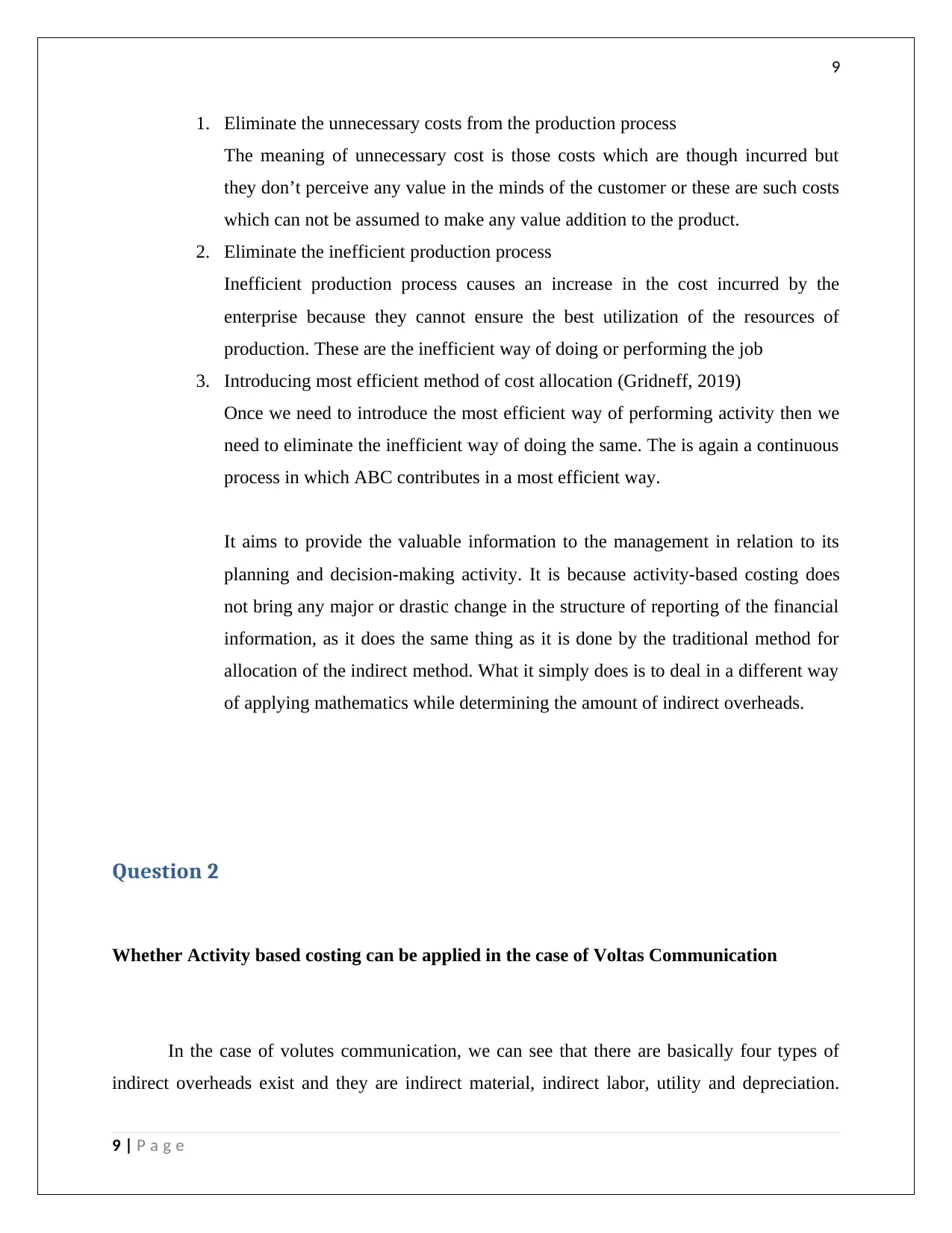
9
1. Eliminate the unnecessary costs from the production process
The meaning of unnecessary cost is those costs which are though incurred but
they don’t perceive any value in the minds of the customer or these are such costs
which can not be assumed to make any value addition to the product.
2. Eliminate the inefficient production process
Inefficient production process causes an increase in the cost incurred by the
enterprise because they cannot ensure the best utilization of the resources of
production. These are the inefficient way of doing or performing the job
3. Introducing most efficient method of cost allocation (Gridneff, 2019)
Once we need to introduce the most efficient way of performing activity then we
need to eliminate the inefficient way of doing the same. The is again a continuous
process in which ABC contributes in a most efficient way.
It aims to provide the valuable information to the management in relation to its
planning and decision-making activity. It is because activity-based costing does
not bring any major or drastic change in the structure of reporting of the financial
information, as it does the same thing as it is done by the traditional method for
allocation of the indirect method. What it simply does is to deal in a different way
of applying mathematics while determining the amount of indirect overheads.
Question 2
Whether Activity based costing can be applied in the case of Voltas Communication
In the case of volutes communication, we can see that there are basically four types of
indirect overheads exist and they are indirect material, indirect labor, utility and depreciation.
9 | P a g e
1. Eliminate the unnecessary costs from the production process
The meaning of unnecessary cost is those costs which are though incurred but
they don’t perceive any value in the minds of the customer or these are such costs
which can not be assumed to make any value addition to the product.
2. Eliminate the inefficient production process
Inefficient production process causes an increase in the cost incurred by the
enterprise because they cannot ensure the best utilization of the resources of
production. These are the inefficient way of doing or performing the job
3. Introducing most efficient method of cost allocation (Gridneff, 2019)
Once we need to introduce the most efficient way of performing activity then we
need to eliminate the inefficient way of doing the same. The is again a continuous
process in which ABC contributes in a most efficient way.
It aims to provide the valuable information to the management in relation to its
planning and decision-making activity. It is because activity-based costing does
not bring any major or drastic change in the structure of reporting of the financial
information, as it does the same thing as it is done by the traditional method for
allocation of the indirect method. What it simply does is to deal in a different way
of applying mathematics while determining the amount of indirect overheads.
Question 2
Whether Activity based costing can be applied in the case of Voltas Communication
In the case of volutes communication, we can see that there are basically four types of
indirect overheads exist and they are indirect material, indirect labor, utility and depreciation.
9 | P a g e
Paraphrase This Document
Need a fresh take? Get an instant paraphrase of this document with our AI Paraphraser
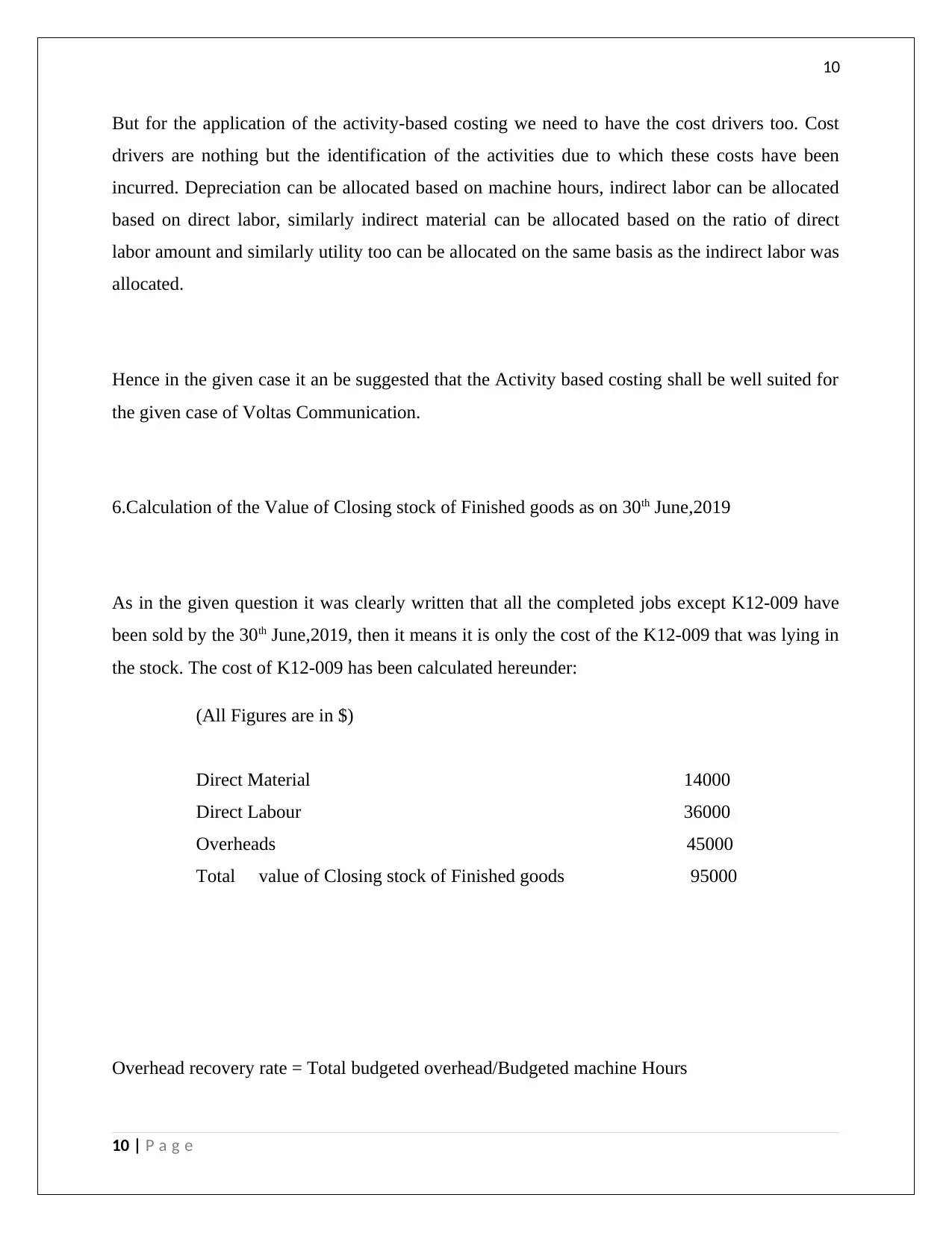
10
But for the application of the activity-based costing we need to have the cost drivers too. Cost
drivers are nothing but the identification of the activities due to which these costs have been
incurred. Depreciation can be allocated based on machine hours, indirect labor can be allocated
based on direct labor, similarly indirect material can be allocated based on the ratio of direct
labor amount and similarly utility too can be allocated on the same basis as the indirect labor was
allocated.
Hence in the given case it an be suggested that the Activity based costing shall be well suited for
the given case of Voltas Communication.
6.Calculation of the Value of Closing stock of Finished goods as on 30th June,2019
As in the given question it was clearly written that all the completed jobs except K12-009 have
been sold by the 30th June,2019, then it means it is only the cost of the K12-009 that was lying in
the stock. The cost of K12-009 has been calculated hereunder:
(All Figures are in $)
Direct Material 14000
Direct Labour 36000
Overheads 45000
Total value of Closing stock of Finished goods 95000
Overhead recovery rate = Total budgeted overhead/Budgeted machine Hours
10 | P a g e
But for the application of the activity-based costing we need to have the cost drivers too. Cost
drivers are nothing but the identification of the activities due to which these costs have been
incurred. Depreciation can be allocated based on machine hours, indirect labor can be allocated
based on direct labor, similarly indirect material can be allocated based on the ratio of direct
labor amount and similarly utility too can be allocated on the same basis as the indirect labor was
allocated.
Hence in the given case it an be suggested that the Activity based costing shall be well suited for
the given case of Voltas Communication.
6.Calculation of the Value of Closing stock of Finished goods as on 30th June,2019
As in the given question it was clearly written that all the completed jobs except K12-009 have
been sold by the 30th June,2019, then it means it is only the cost of the K12-009 that was lying in
the stock. The cost of K12-009 has been calculated hereunder:
(All Figures are in $)
Direct Material 14000
Direct Labour 36000
Overheads 45000
Total value of Closing stock of Finished goods 95000
Overhead recovery rate = Total budgeted overhead/Budgeted machine Hours
10 | P a g e
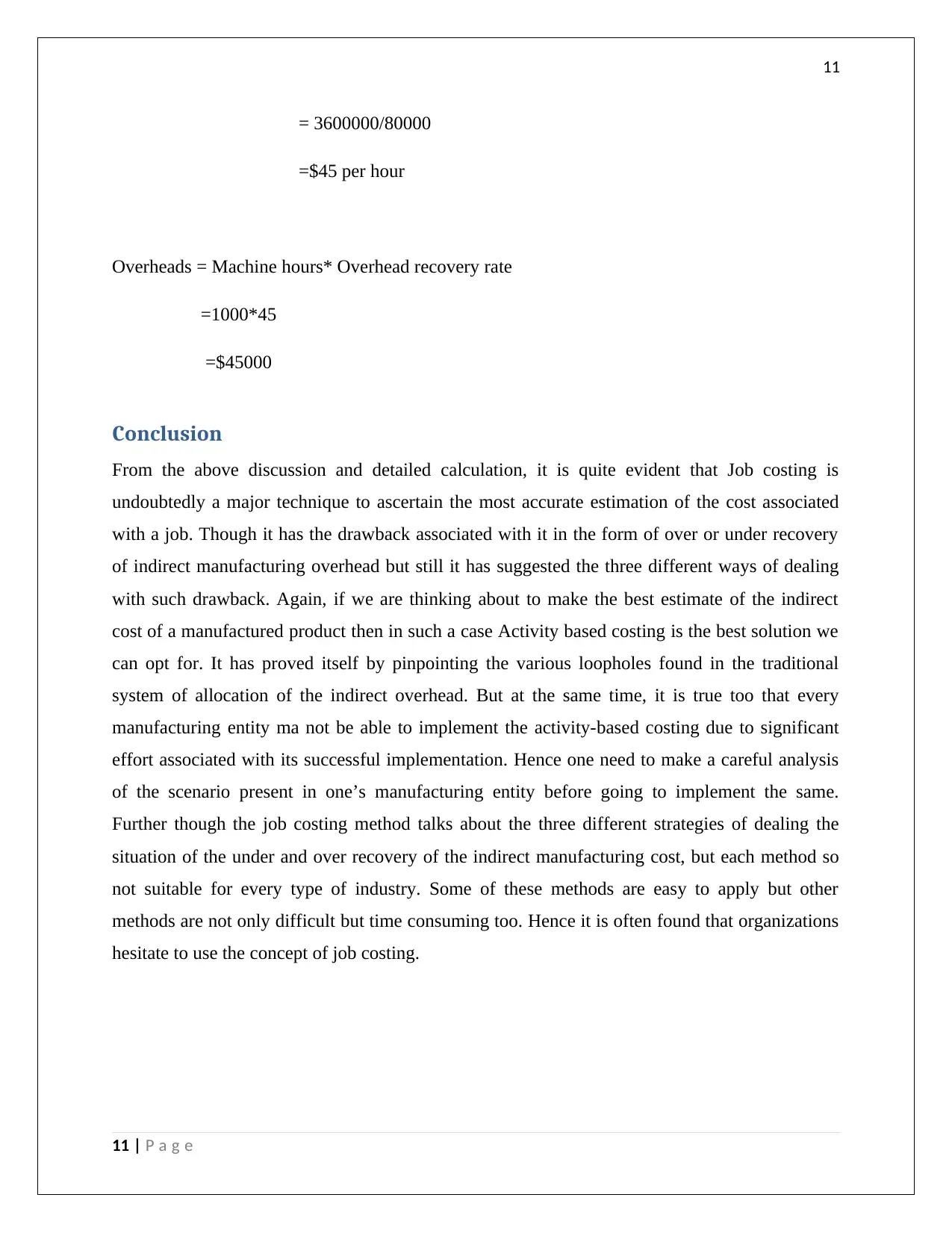
11
= 3600000/80000
=$45 per hour
Overheads = Machine hours* Overhead recovery rate
=1000*45
=$45000
Conclusion
From the above discussion and detailed calculation, it is quite evident that Job costing is
undoubtedly a major technique to ascertain the most accurate estimation of the cost associated
with a job. Though it has the drawback associated with it in the form of over or under recovery
of indirect manufacturing overhead but still it has suggested the three different ways of dealing
with such drawback. Again, if we are thinking about to make the best estimate of the indirect
cost of a manufactured product then in such a case Activity based costing is the best solution we
can opt for. It has proved itself by pinpointing the various loopholes found in the traditional
system of allocation of the indirect overhead. But at the same time, it is true too that every
manufacturing entity ma not be able to implement the activity-based costing due to significant
effort associated with its successful implementation. Hence one need to make a careful analysis
of the scenario present in one’s manufacturing entity before going to implement the same.
Further though the job costing method talks about the three different strategies of dealing the
situation of the under and over recovery of the indirect manufacturing cost, but each method so
not suitable for every type of industry. Some of these methods are easy to apply but other
methods are not only difficult but time consuming too. Hence it is often found that organizations
hesitate to use the concept of job costing.
11 | P a g e
= 3600000/80000
=$45 per hour
Overheads = Machine hours* Overhead recovery rate
=1000*45
=$45000
Conclusion
From the above discussion and detailed calculation, it is quite evident that Job costing is
undoubtedly a major technique to ascertain the most accurate estimation of the cost associated
with a job. Though it has the drawback associated with it in the form of over or under recovery
of indirect manufacturing overhead but still it has suggested the three different ways of dealing
with such drawback. Again, if we are thinking about to make the best estimate of the indirect
cost of a manufactured product then in such a case Activity based costing is the best solution we
can opt for. It has proved itself by pinpointing the various loopholes found in the traditional
system of allocation of the indirect overhead. But at the same time, it is true too that every
manufacturing entity ma not be able to implement the activity-based costing due to significant
effort associated with its successful implementation. Hence one need to make a careful analysis
of the scenario present in one’s manufacturing entity before going to implement the same.
Further though the job costing method talks about the three different strategies of dealing the
situation of the under and over recovery of the indirect manufacturing cost, but each method so
not suitable for every type of industry. Some of these methods are easy to apply but other
methods are not only difficult but time consuming too. Hence it is often found that organizations
hesitate to use the concept of job costing.
11 | P a g e
⊘ This is a preview!⊘
Do you want full access?
Subscribe today to unlock all pages.

Trusted by 1+ million students worldwide
1 out of 14
Related Documents
Your All-in-One AI-Powered Toolkit for Academic Success.
+13062052269
info@desklib.com
Available 24*7 on WhatsApp / Email
![[object Object]](/_next/static/media/star-bottom.7253800d.svg)
Unlock your academic potential
Copyright © 2020–2025 A2Z Services. All Rights Reserved. Developed and managed by ZUCOL.





